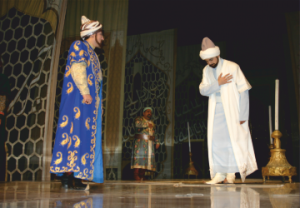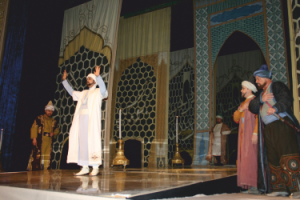Munavvara Abdullaeva,
Director
By declaring that “Theatre is a collective art” Stanislavsky has accurately and concisely expressed the entire creative process of the performance. In disclosing the nature and content, specifics of the idea of the staged work, the input of the stage decorator is significant, since the artist by creating decorations of the stage, highlights and enriches the performance of the actors. He is the person expressing the general content , as well as the purpose of production. Therefore, the creative union of the director and the artist is important in staging any performance.
 The artist applies the visual art, architecture and special lighting techniques to create a historical period, location, and specific circumstances. These attributes of the set, if in tune with the play, movements, roles performed by the actors, create a single entity required for successful assimilation of the content of the play by the audience. However, these requisites always have one strict requirement – they must be simple and at the same time have a meaningful purpose, which is to work on the disclosure of the essence of the events unfolding on the stage, and not to interfere with the actors’ performance. The results of creative search of the artist – whether it relates to the fine or applied arts, or architectural construction – should not be alienated from the play. Requirements for the decorator of the stage sharply differ from the requirements to other painters. If the artist of the fine arts captures any particular landscape or specific place, a particular person, the artist of the stage creates the ever changing composition of the scene, expressing the cycle of events. The painter reveals his attitude, expresses his ideas, his vision of the world on the canvas; the stage artist tries to disclose more fully the nature and the essence of the dramatic piece.
The artist applies the visual art, architecture and special lighting techniques to create a historical period, location, and specific circumstances. These attributes of the set, if in tune with the play, movements, roles performed by the actors, create a single entity required for successful assimilation of the content of the play by the audience. However, these requisites always have one strict requirement – they must be simple and at the same time have a meaningful purpose, which is to work on the disclosure of the essence of the events unfolding on the stage, and not to interfere with the actors’ performance. The results of creative search of the artist – whether it relates to the fine or applied arts, or architectural construction – should not be alienated from the play. Requirements for the decorator of the stage sharply differ from the requirements to other painters. If the artist of the fine arts captures any particular landscape or specific place, a particular person, the artist of the stage creates the ever changing composition of the scene, expressing the cycle of events. The painter reveals his attitude, expresses his ideas, his vision of the world on the canvas; the stage artist tries to disclose more fully the nature and the essence of the dramatic piece.
The play “Mirzo Ulugbek” is a vivid example of a creative collaboration of the director and the artist in creation of the performance adapted by the work of the writer Maksud Shayhzoda and prepared for performance in 1989, by the People’s Artist of Uzbekistan – Turgun Azizov and the artist – Ubaidulla Saidaliev. According to their concept, Ulugbek ascends the steep steps of a very high staircase and flies upwards – to the stars, while the patricide Abdullatif, damned by the people, falls into the abyss. The bright idea of the director and the stage artist that concludes the play has turned out to be a successful solution of its final scene and the plot itself.
The work of the director and the artist begins with selection of a play to be staged. The prelude of their future collaboration is the period of interchange of their opinions regarding the script. Certainly, the director and the artist have their own ideas, views and positions; however their priority is still a common goal – the idea expressed by the playwright.
 At the beginning of working together the director and the artist must first read and study the previously staged versions of the piece (if this is the case). If it is a play of historical theme or translated work of the foreign literature, it is important to study that period, social layer and way of life of the people, its distinctive features, habits, traditions and spirit of that epoch and the historical relevance of the literary work. The process of creative research of the director and the artist may bring to complete understanding or disagreement between them. However, no matter what the circumstances are and whatever decision they may come to, each other’s creative approach and views must be respected, since the unanimity of opinion is the foundation for further work of the creative duo. While presenting the text of a script to an artist for reading, a director shares with him his impressions and ideas about the looks of the characters, their temper, social background, the issues and specific situations of the play and the period of history, in which the events occur. In the process of familiarization with the work both the artist and the director expresses their points of view, their vision of the main dramatic conflict, their understanding of the ideological content and images and the characters. Only after a detailed study and exchange of views begins a creative collaboration. First of all, there is a phase of so-called “rough reading”, after which the stage background and decoration is being outlined, as well as suggestions of the director and other arrangements are being discussed. The work of the makeup artist, selection of costumes, color scheme and lighting options go on, starting from the day of the play’s reading by the director and the artist the works do not stop until the staging of the play.
At the beginning of working together the director and the artist must first read and study the previously staged versions of the piece (if this is the case). If it is a play of historical theme or translated work of the foreign literature, it is important to study that period, social layer and way of life of the people, its distinctive features, habits, traditions and spirit of that epoch and the historical relevance of the literary work. The process of creative research of the director and the artist may bring to complete understanding or disagreement between them. However, no matter what the circumstances are and whatever decision they may come to, each other’s creative approach and views must be respected, since the unanimity of opinion is the foundation for further work of the creative duo. While presenting the text of a script to an artist for reading, a director shares with him his impressions and ideas about the looks of the characters, their temper, social background, the issues and specific situations of the play and the period of history, in which the events occur. In the process of familiarization with the work both the artist and the director expresses their points of view, their vision of the main dramatic conflict, their understanding of the ideological content and images and the characters. Only after a detailed study and exchange of views begins a creative collaboration. First of all, there is a phase of so-called “rough reading”, after which the stage background and decoration is being outlined, as well as suggestions of the director and other arrangements are being discussed. The work of the makeup artist, selection of costumes, color scheme and lighting options go on, starting from the day of the play’s reading by the director and the artist the works do not stop until the staging of the play.
For example, the artist has found an excellent solution for disclosure of the idea of the play “Alisher Navoi” (staged in 1991 by the People’s Artist of Uzbekistan, T. Azizov, adaptation of the novel of Uyghun and Izzat Sultan, artist – Anatoliy Jiboedov). The moment of peak tension in the play is appearance of a long path made of fine fabric going through the center of the scene upwards. Along the entire length of it the precious heritage of the nation is inscribed – the titles of the works of the great Uzbek poet – Alisher Navoi.
Another instance of how the artist creates a theatrical scenery of general background for a play is “Mashrab” (staged in 1997 by the author of present article together with the People’s Artist of Uzbekistan T. Azizov. Playwright – E. Khushvaktov, artists – Bakhtiyor Turaev, Tulkin Ruziyev). Stage set, although unsophisticated from a philosophical view, clearly revealed the theme: a circle in the middle of the stage as a symbol of fate, heaven, the wheel of fortune. All the events are developing around it.
Often times the audience welcomes the beginning of the play and the uplift of the curtain with applause. They applaud louder and longer, if the artist was able to recreate a spectacular stage set, worthy of admiration. The main objective of the theater artist is to create the environment peculiar to a certain epoch on stage using the theatrical scenery.
In the theater parlance the notion of “the spirit of the play” is often used. It means the way and the means with the help of which the artist ecreates the stage settings.
First impressions of a spectator about the play appear with the uplift of the curtain, and opening of the scenery, pictures, and color palette on stage. Whether this impression will be positive or not depends largely on the work of the artist. It is important to construct the set in a way, when composition of specific mise en scene does not distract the viewer from the main story. It happens that the artist has to work with director, who has just embarked on this path. In this case, as long as the director and the young actors do not come to a single vision of the play, the artists have to work relying on their knowledge. In this process, a remark, a description of the scene by the author of the play is the best help for an artist who, expressing his vision of the accumulated information, should consider the creative solutions of director, adjusting his project according to his comments.
